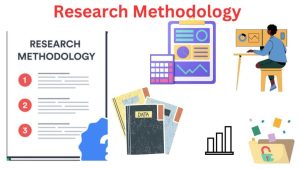Research Methodology, Objectives, Types, Qualities of good research report.

Research Methodology, Objectives, Types, Qualities of good research report.
Meaning Of Research Methodology:
Research methodology refers to the systematic and logical process followed during a research study. It is a structured way of investigating, analyzing, and interpreting a topic or a problem in order to gain a deeper understanding and generate new knowledge. Research methodology outlines the overall approach, techniques, procedures, and tools that researchers use to conduct research and collect relevant data.
The main purpose of research methodology is to ensure that the research process is conducted in a rigorous, systematic, and unbiased manner. It provides a framework for designing the study, collecting and analyzing data, and drawing conclusions. A well-defined research methodology is crucial for the credibility and validity of research findings, as it helps researchers avoid errors, biases, and inconsistencies in their work.
In summary, research methodology encompasses the methods, techniques, and procedures employed by researchers to conduct a study, answer research questions, and contribute to the existing body of knowledge in a specific field. It serves as a blueprint for the entire research process, guiding researchers from the initial conceptualization of the study to the presentation and interpretation of the results.
Definition Of Research Methodology:
- Research methodology is a way to systematically solve the research problem. It may be understood as a science of studying how research is done scientifically. In it we study the various steps that are generally adopted by a researcher in studying his research problem along with the logic behind them.
- Research methodology refers to the systematic and structured set of techniques and procedures employed by researchers to plan, conduct, and analyze research. It outlines the strategies, methods, and tools used to gather, evaluate, and interpret data in a way that ensures the research is valid, reliable, and credible. Research methodology guides the entire research process, from the formulation of research questions to the presentation of findings, and helps researchers make informed and evidence-based conclusions. It also includes the philosophical underpinnings that influence the researcher’s approach, such as positivism, interpretivism, or critical theory, among others.
Objectives Of Research Methodology:
Research methodology is a crucial aspect of any research project, as it provides a systematic approach to conducting research. The primary objectives of research methodology include:
- To Establish Credibility: Research methodology helps ensure that the research is conducted in a rigorous and systematic manner, which enhances the credibility and reliability of the research findings.
- To Achieve Research Objectives: Research methodology assists in defining clear research objectives and formulating research questions or hypotheses, helping researchers stay focused on their goals.
- To Ensure Replicability: By outlining the research methods and procedures, research methodology allows other researchers to replicate the study to validate the results or conduct further investigations.
- To Minimize Bias: Research methodology provides techniques and strategies to minimize bias and errors in data collection, analysis, and interpretation, thereby improving the validity of research outcomes.
- To Select Appropriate Methods: It helps in selecting the most appropriate research methods, data collection techniques, and analytical tools based on the research questions, objectives, and the nature of the data.
- To Optimize Resource Utilization: Research methodology assists in efficient resource allocation, including time, money, and personnel, by helping researchers make informed decisions on data collection, sampling, and analysis.
- To Ensure Ethical Conduct: Research methodology includes guidelines for ethical conduct in research, such as obtaining informed consent from participants, protecting their confidentiality, and ensuring that the research adheres to ethical standards.
- To Systematically Organize Information: It provides a framework for organizing and analyzing data, making it easier to draw meaningful conclusions from the research.
- To Enhance Generalizability: Research methodology aids in selecting appropriate samples and sampling methods to improve the generalizability of research findings to a broader population.
- To Minimize Errors: It helps in identifying potential sources of error and bias in the research process and provides strategies to minimize or control these sources.
- To Improve Decision-Making: The ultimate goal of research is often to inform decision-making, and research methodology ensures that the information generated is of high quality, thus aiding in sound decision-making.
- To Contribute to Knowledge: Research methodology is the foundation for producing new knowledge, advancing existing knowledge, and contributing to the academic or practical understanding of a subject.
FOLLOW US :
Instagram :- instagram/allnationalnews
YouTube :- youtube/@allnationalnews
Facebook :- All National News
Types Of Research Methodology:
Research methodology refers to the systematic processes and techniques used to conduct research, gather information, and analyze data in a structured and reliable manner. There are various types of research methodologies, each suited to different research objectives and questions. Here are some of the most common types of research methodologies:
- Quantitative Research: This methodology involves the collection and analysis of numerical data. It aims to quantify relationships, patterns, and trends in data. Common quantitative methods include surveys, experiments, content analysis, and statistical analysis.
- Qualitative Research: Qualitative research focuses on understanding the meaning, context, and subjective experiences of research subjects. It often involves in-depth interviews, focus groups, participant observation, and content analysis of non-numerical data, such as text, images, or videos.
- Mixed-Methods Research: This approach combines both quantitative and qualitative research methods to provide a more comprehensive understanding of a research problem. Researchers collect and analyze both numerical and non-numerical data to answer research questions.
- Descriptive Research: Descriptive research is used to describe the characteristics of a population or phenomenon. It does not involve making causal inferences but rather focuses on understanding and summarizing the current state of affairs.
- Correlational Research: Correlational research explores the relationships between variables without manipulating them. It assesses the degree and direction of the association between two or more variables, but it does not establish causation.
- Experimental Research: Experimental research involves manipulating one or more variables to observe their impact on other variables. It is designed to establish cause-and-effect relationships and is often conducted in controlled laboratory settings.
- Survey Research: Surveys are a popular method for collecting data from a large number of respondents using structured questionnaires. They are often used in quantitative research to gather information about attitudes, opinions, and behaviors.
- Case Study Research: Case studies involve an in-depth analysis of a single individual, group, or organization. Researchers gather detailed information to provide a holistic understanding of the case under study.
- Action Research: Action research is often used in education and social sciences. It involves collaboration between researchers and practitioners to solve real-world problems and improve practices.
- Content Analysis: Content analysis is a method used to analyze the content of textual, visual, or audio material. Researchers examine the content for patterns, themes, and meanings.
- Historical Research: Historical research involves the study of past events and their contexts. Researchers rely on historical documents, records, and artifacts to analyze and interpret historical phenomena.
- Grounded Theory: Grounded theory is a qualitative research method that aims to develop theories from data. Researchers collect and analyze data without preconceived hypotheses and generate theories based on the emerging patterns.
- Ethnographic Research: Ethnography involves immersive fieldwork in a particular cultural or social setting to gain an in-depth understanding of the behaviors, beliefs, and practices of the people within that setting.
- Longitudinal Research: Longitudinal studies follow the same group of individuals or entities over an extended period to observe changes and trends over time.
- Comparative Research: Comparative research involves the examination of similarities and differences across different groups, regions, or contexts to identify patterns and relationships.
Characteristics of good sample design:
A good sample design is crucial in research as it directly impacts the reliability and validity of your study’s results. Here are some key characteristics of a good sample design:
- Representativeness: The sample should be a true reflection of the population you are studying. It should include the key characteristics and variations present in the population to ensure that the findings can be generalized.
- Randomization: Random selection of participants reduces bias and ensures that every individual or element in the population has an equal chance of being included in the sample. Random sampling methods include simple random sampling, stratified random sampling, and systematic random sampling.
- Adequate Sample Size: The sample size should be large enough to provide sufficient statistical power for the study. A small sample may lead to low precision and unreliable results, while an excessively large sample may be costly and time-consuming without providing substantial benefits.
- Sampling Frame: A good sample design relies on a well-defined and accessible sampling frame, which is a list or source from which the sample is drawn. The sampling frame should be complete, up-to-date, and closely related to the population of interest.
- Sampling Method: The choice of sampling method should be appropriate for the research objectives and the population. Common sampling methods include simple random sampling, stratified sampling, cluster sampling, and systematic sampling.
- Sampling Bias Minimization: Efforts should be made to minimize various types of bias, such as selection bias, non-response bias, and measurement bias. Biases can distort the results and make them less generalizable.
- Sampling Precision: The sample design should aim for a level of precision that is acceptable for the research goals. This precision is often expressed in terms of confidence intervals and margins of error.
- Ethical Considerations: The sample design should adhere to ethical principles, including informed consent, confidentiality, and respect for the rights and well-being of the participants.
- Cost-Effectiveness: A good sample design should balance the cost of data collection with the research objectives. It should seek to minimize costs while achieving the necessary level of accuracy and reliability.
- Feasibility: The chosen sample design should be practical and feasible within the constraints of time, budget, and available resources.
- Appropriate Sampling Technique: Depending on the research question and the characteristics of the population, different sampling techniques may be more suitable. For example, purposive or convenience sampling may be used when access to the entire population is difficult.
- Sampling Error Consideration: Researchers should be aware of the potential for sampling error and account for it in the analysis and interpretation of results. The margin of error should be clearly reported.
- Documentation: The sample design should be thoroughly documented, including the rationale behind the chosen approach, the sampling frame, the sampling method, and any adjustments made during data collection.
Qualities of good research report:
A good research report is an essential component of the research process, as it serves as the means to communicate the findings, methods, and implications of a study to the academic or professional community. Here are some qualities of a good research report and an explanation of each:
- Clarity: The report should be clear and concise. The language used should be easily understandable, and technical terms should be defined or explained when necessary. Avoid unnecessary jargon and complex language that might hinder comprehension.
- Logical Structure: The report should follow a logical and organized structure. It typically includes sections such as the introduction, literature review, methodology, results, discussion, and conclusion. Each section should flow smoothly, building on the previous one to tell a coherent and structured story.
- Relevance: The report should stay focused on the research objectives and research questions. Avoid including irrelevant information or going off on tangents. Every element in the report should directly contribute to the study’s goals.
- Objectivity: The report should maintain an objective and unbiased tone. Research findings and interpretations should be presented in an impartial manner, and any potential conflicts of interest should be disclosed.
- Comprehensive Literature Review: The report should provide a thorough review of existing literature relevant to the research topic. This not only demonstrates the researcher’s understanding of the field but also helps place the study in context.
- Detailed Methodology: The research report should include a clear and detailed description of the research methodology. This should enable other researchers to replicate the study if needed. It should describe the data collection methods, sampling techniques, and data analysis procedures.
- Transparency: The report should be transparent in terms of data sources, data collection instruments, and any limitations of the study. Transparency enhances the credibility of the research.
- Evidence-Based Findings: Findings should be based on empirical evidence and data collected during the research. The report should provide statistical or qualitative data to support the claims made.
- Interpretation and Discussion: The report should not merely present data but also provide a thoughtful analysis and interpretation of the findings. This helps readers understand the implications of the research and how it contributes to the existing body of knowledge.
- Citations and References: All sources of information, including prior research, must be appropriately cited. This shows respect for the work of others and helps readers locate the original sources.
- Conciseness: While being comprehensive, the report should also be concise. Avoid unnecessary repetition, overly lengthy explanations, and excessive detail that might overwhelm the reader.
- Visual Aids: Effective use of tables, figures, charts, and graphs can make complex data more accessible. These visual aids should be well-labeled and integrated with the text.
- Proper Formatting: The research report should follow the appropriate formatting style and citation style guidelines (e.g., APA, MLA, Chicago). Consistency in formatting and citation is essential.
- Timeliness: The report should be delivered in a timely manner, allowing for the relevance and currency of the research findings.
- Engaging Presentation: A good research report should engage the reader. Use clear headings, subheadings, and a visually appealing layout to make the report user-friendly.
FOLLOW US :
Instagram :- instagram/allnationalnews
YouTube :- youtube/@allnationalnews
Facebook :- All National News
Research methodology refers to the systematic and organized approach researchers use to design, conduct, and analyze a study. It encompasses the methods, procedures, and rules guiding the research process, ensuring the generation of reliable and valid results. Key components include research design, sampling, data collection, analysis, validity, reliability, ethical considerations, and the documentation of findings.
Research is a systematic and methodical investigation or inquiry that aims to discover, interpret, or revise facts, theories, and principles. It involves a careful and organized process of gathering, analyzing, and interpreting information to answer specific questions, solve problems, or contribute to the existing body of knowledge in a particular field. Research may be conducted through various methods, including experimentation, observation, surveys, literature reviews, and other systematic approaches, depending on the nature of the inquiry and the discipline involved. The ultimate goal of research is to advance understanding and knowledge in a given subject area.
Research methodology refers to the systematic and organized process of planning, conducting, and analyzing research activities. It encompasses the techniques, procedures, and principles used to gather and interpret data in order to address a specific research question or problem.









Leave a Reply